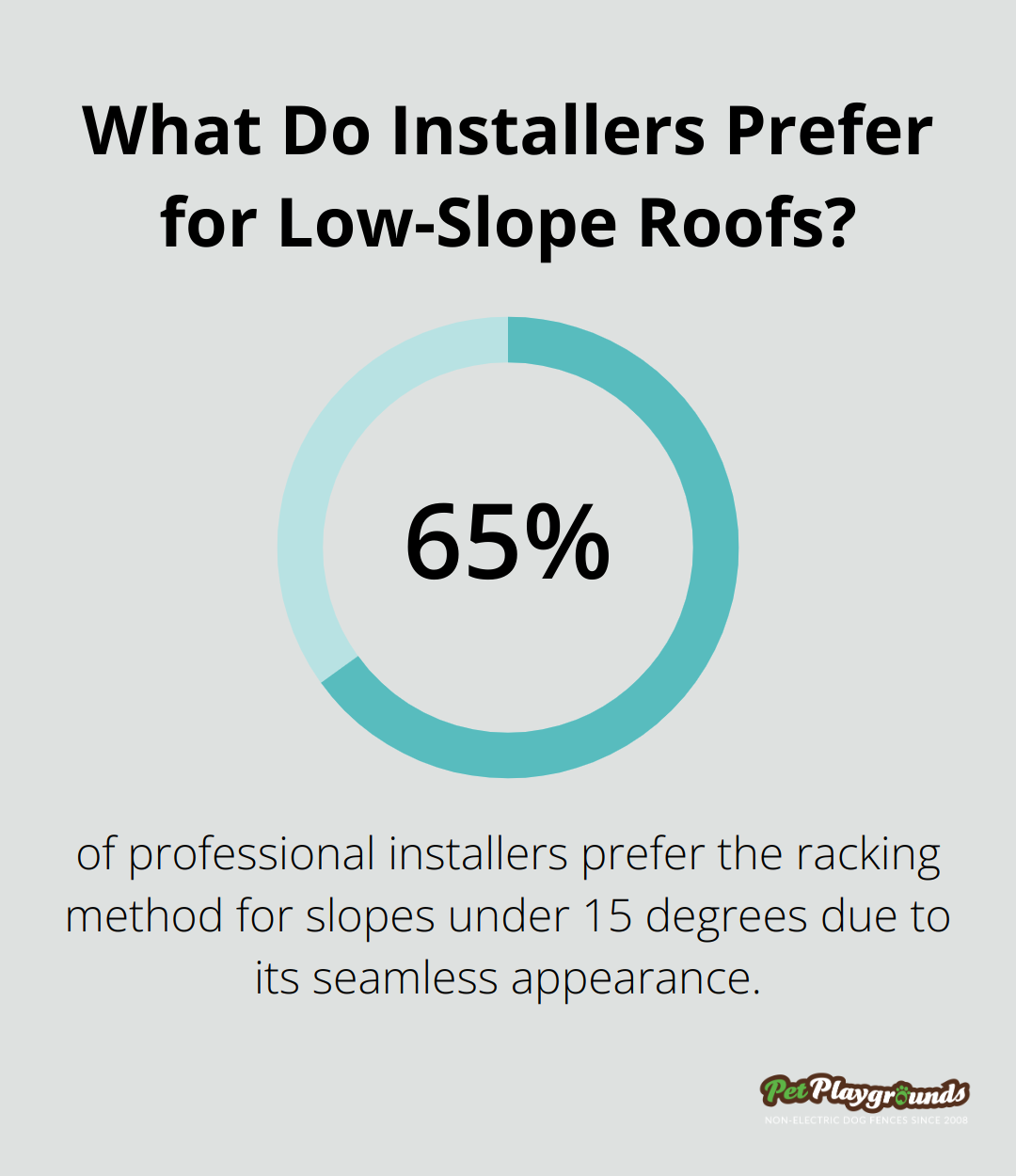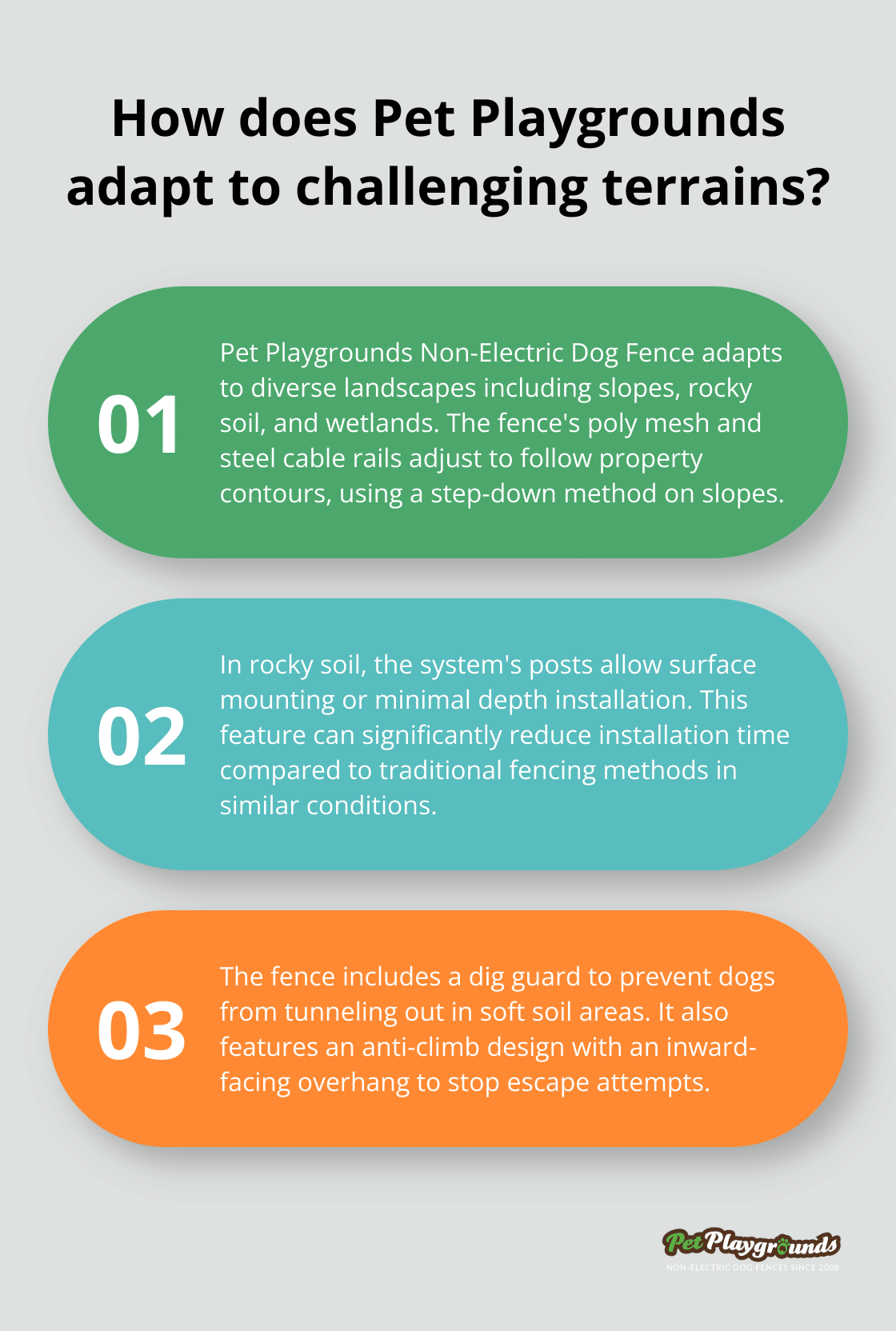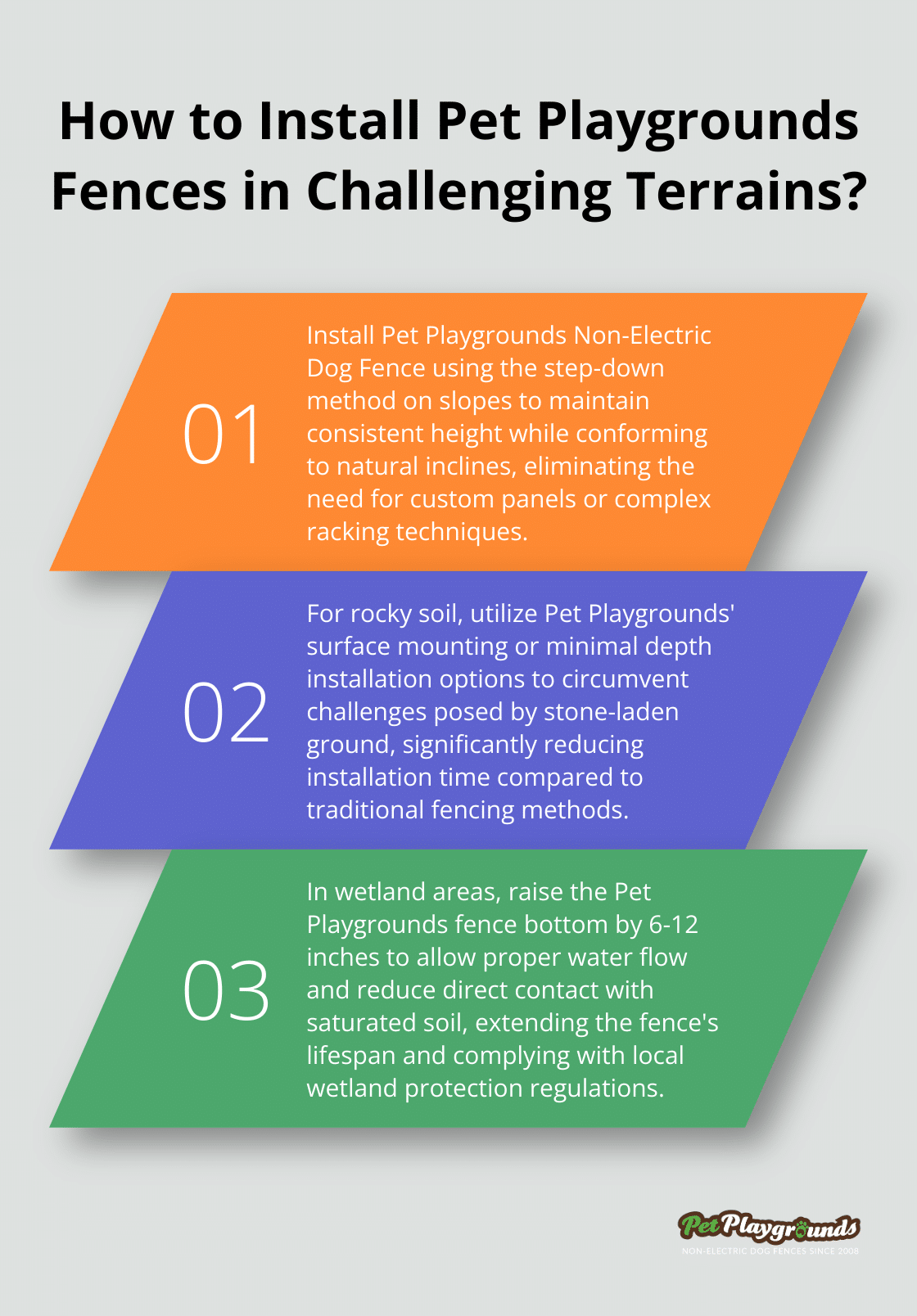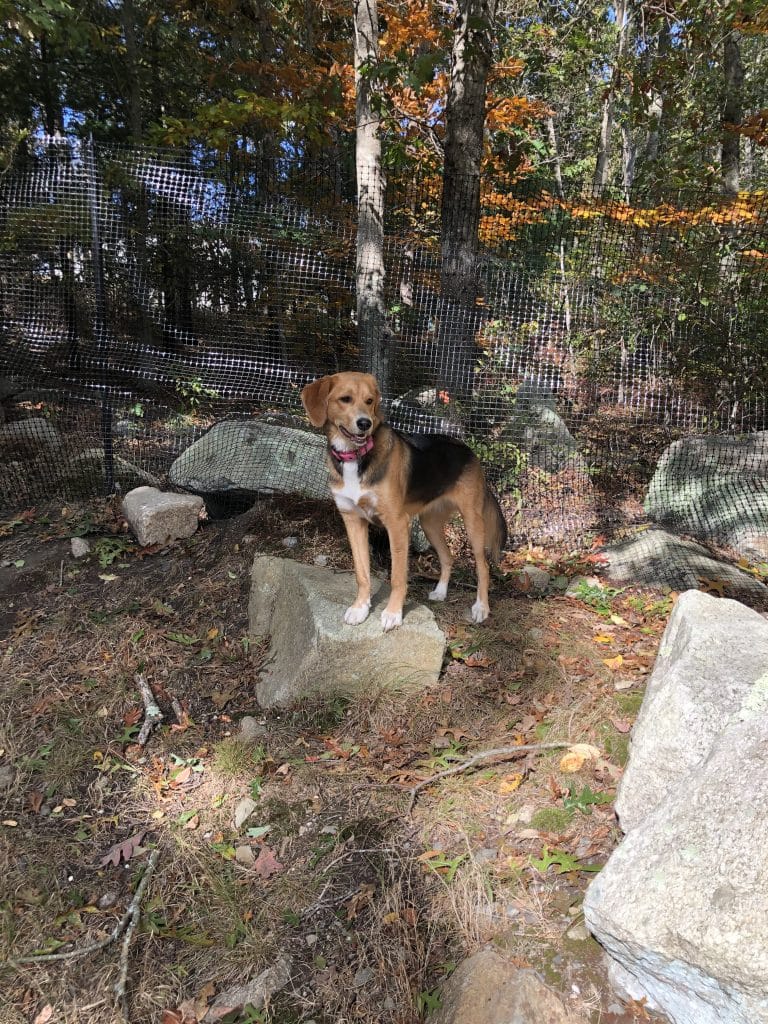Fencing your property can be a challenge when faced with tricky terrains. From steep slopes to rocky soil and wetlands, homeowners often struggle to find suitable fencing solutions.
At Pet Playgrounds Non Electric Dog Fence, we understand these challenges and offer flexible fencing options that adapt to various landscapes. Our guide will help you navigate the complexities of installing fences on difficult terrains and showcase innovative solutions for your property.
What Makes Terrain Challenging for Fencing?
Fencing a property isn’t always straightforward. Slopes, rocky soil, and wetlands can turn a simple project into a complex endeavor. These challenging terrains present unique obstacles that require careful consideration and specialized solutions.
The Slope Dilemma
Sloped yards are among the most common fencing challenges homeowners face. A survey reveals that 78% of ASLA members are registered landscape architects, with 15% being associate members. Steep inclines can cause fences to look uneven or create gaps at the bottom, which compromises both aesthetics and security.

For example, a 30-degree slope can result in a 6-inch gap at the fence’s base over just 10 feet of run. This not only looks unsightly but also provides an escape route for smaller pets. Traditional fencing methods often fail to adapt, which leads to increased costs and installation time.
Rocky Realities
Rocky soil poses another significant hurdle. The National Association of Home Builders represents the largest network of craftsmen, innovators and problem solvers dedicated to building and enriching communities. These areas make digging post holes a nightmare, often requiring specialized equipment or alternative installation methods.
In extreme cases, homeowners might need to rent pneumatic drills or hire professionals with hydraulic augers. This can drive up costs compared to standard installations. Moreover, rocky terrain can lead to poor post stability if not addressed properly, which results in leaning or fallen fences within a few years.
Wetland Woes
Wetlands present a unique set of challenges for fencing. These areas are characterized by high moisture content and often unstable soil conditions.
Fencing in wetlands requires materials that can withstand constant exposure to moisture without rotting or rusting. Standard wooden posts, for example, can decay within 2-3 years in wetland conditions, even when pressure-treated. Additionally, local regulations often restrict fencing in wetland areas to protect ecosystems, which adds another layer of complexity to the project.
The Need for Adaptable Solutions
These terrain challenges highlight the importance of choosing the right fencing solution for each unique property. Traditional fencing methods often fall short when faced with slopes, rocks, or wet conditions. This reality has spurred innovation in the fencing industry, leading to the development of more flexible and adaptable fencing systems.
Homeowners now have access to fencing options that can overcome these obstacles without extensive ground preparation or specialized equipment. These modern solutions (such as the Pet Playgrounds Non-Electric Dog Fence) offer versatility and ease of installation across various landscapes, making them ideal for properties with challenging terrains.
As we explore fencing solutions for different terrain types, we’ll discover how these innovative approaches can transform even the trickiest landscapes into secure and attractive spaces for both humans and pets.
Tackling Tricky Terrains with Smart Fencing Solutions
Conquering Slopes: Step and Rack Methods
Sloped yards challenge fence installers, but step and rack methods offer effective solutions. The step method installs fence panels in a stair-step pattern, maintaining level sections while following the slope’s contour. This approach works well for steep inclines, with each panel stepping down at regular intervals.

For gentler slopes, the racking method allows fence panels to follow the terrain’s natural angle. This technique maintains a consistent gap between the ground and fence bottom, eliminating unsightly spaces that could compromise security. A survey by the American Fence Association found that 65% of professional installers prefer the racking method for slopes under 15 degrees due to its seamless appearance.
Custom panels provide another option for extremely uneven terrain. These made-to-order sections match your yard’s unique topography, ensuring a perfect fit. While more expensive, custom panels offer unparalleled adaptability and aesthetic appeal.
Overcoming Rocky Soil: Innovative Installation Techniques
Rocky soil transforms a simple fence installation into a complex task. However, above-ground installation techniques and reinforced posts offer practical workarounds. Surface-mounted post bases, anchored with heavy-duty concrete screws, provide stability without deep digging. This method proves particularly effective in areas with shallow bedrock or dense stone concentrations.
For added strength in rocky conditions, reinforced posts feature additional support structures or thicker walls to withstand the pressures of unstable ground. The International Association of Certified Home Inspectors reports that reinforced posts can increase a fence’s lifespan by up to 30% in challenging soil conditions.
Weathering Wetlands: Specialized Materials and Designs
Fencing wetlands requires materials that withstand constant moisture exposure. Rust-resistant options like vinyl, aluminum, or specialized coated steel offer durability in these damp environments. The Vinyl Fence Manufacturers Association states that high-quality vinyl fencing can last up to 30 years in wetland conditions with minimal maintenance.
Elevated designs play a key role in wetland fencing. Raising the fence bottom by 6-12 inches allows proper water flow and reduces direct contact with saturated soil. This approach not only extends the fence’s lifespan but also complies with many local wetland protection regulations.
Adaptable Solutions for Diverse Landscapes
For properties with varied terrain challenges, adaptable fencing systems offer versatility without extensive ground preparation. These flexible designs accommodate slopes, rocky areas, and wet conditions, making them excellent choices for properties with diverse landscape features.
The Pet Playgrounds Non-Electric Dog Fence system stands out as a top choice among adaptable solutions. Its unique design allows for easy installation across different terrains (including slopes and rocky areas) without the need for concrete or extensive labor. This system provides a secure environment for pets while adapting seamlessly to existing landscapes.
As we explore specific fencing options for challenging terrains, we’ll discover how innovative approaches like the Pet Playgrounds system can transform even the trickiest landscapes into secure and attractive spaces for both humans and pets.
How Pet Playgrounds Tackles Tricky Terrains
Adaptability to Diverse Landscapes
Pet Playgrounds Non-Electric Dog Fence offers a versatile solution for homeowners with challenging landscapes. This system adapts to various terrains, making it suitable for properties with slopes, rocky soil, or wetlands.

The fence’s design allows for quick installation across different terrains. Its combination of poly mesh and steel cable rails adjusts to follow property contours. On sloped areas, installers can use a step-down method to maintain consistent height while conforming to natural inclines. This approach eliminates the need for custom panels or complex racking techniques.
In rocky soil, where deep post holes prove impossible, Pet Playgrounds excels. The system’s posts allow surface mounting or minimal depth installation, which circumvents challenges posed by stone-laden ground. This feature can cut installation time significantly compared to traditional fencing methods in similar conditions.
Enhanced Security Features
Pet Playgrounds incorporates robust security features beyond adaptability. The fence’s dig guard extends underground to prevent dogs from tunneling out (particularly useful in areas with soft soil or where burrowing animals are common). Its anti-climb design, with an inward-facing overhang, stops even determined escape artists. Neutered male dogs are less likely to try to escape a fence or mark inside the house, which can also help solve escape problems.
Efficient Installation Process
The straightforward installation process of Pet Playgrounds appeals to many homeowners. The system doesn’t require concrete or heavy machinery, which makes it accessible for DIY enthusiasts and reduces professional installation costs.
Installers can set up a 100-foot perimeter in just a few hours, even on challenging terrain. This efficiency allows homeowners to secure their property quickly without disrupting their landscape.
The fence’s lightweight yet durable components allow easy maneuvering around obstacles like trees or large rocks. This flexibility ensures preservation of a yard’s natural features while creating a secure space for pets.
Customization Options
Pet Playgrounds offers customization options to suit different dog breeds and sizes. The system provides various heights and mesh strengths to accommodate small, medium, and large dogs. This tailored approach ensures optimal security for each unique pet situation.
Long-Term Investment
The durability of Pet Playgrounds materials makes it a long-lasting investment. The Bitter Pro-infused poly mesh deters chewing, while the strong steel cable rails withstand environmental stresses. This combination of features creates a Private dog park that can positively impact a dog’s life, health, and even trainability.
Final Thoughts
Fencing in challenging terrains presents unique obstacles, but homeowners can successfully secure their properties with the right approach. Slopes, rocky soil, and wetlands each require specific strategies to ensure a stable, long-lasting fence. Property owners can overcome even the trickiest landscapes through innovative fencing options.

Flexible fencing solutions have transformed the way we approach difficult terrains. These systems offer versatility without extensive ground preparation, making them ideal for properties with diverse landscape features. Pet Playgrounds Non-Electric Dog Fence stands out as a prime example of adaptable fencing that tackles various terrain challenges effectively.
We encourage homeowners to assess their terrain and consider the long-term benefits of choosing an adaptable fencing solution. Pet Playgrounds adapts to slopes, rocky areas, and wetlands, offering a secure environment for pets without compromising on aesthetics or ease of installation (no concrete or heavy machinery required). This system can help create a safe, enjoyable area that enhances both the property’s value and the quality of life for its four-legged residents.
























